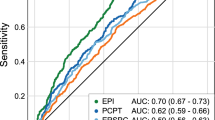Abstract
Introduction
The prostate cancer gene 3 (PCA3) test is based on the analysis of tumor cell mRNA in urine. As an exprimated urinary marker, its retrieval is subject to certain physical aspects like palpation pressure and detachment force during the squeezing of cells. Other potential factor of influence may be the distance the cells have to cover until they reach the urethra. Thus, it was investigated whether the localization of the tumors within the prostate with regard to the urethra and the seminal colliculus influences the PCA3 score.
Methods
Prostatectomy specimens of 55 organ-confined prostate cancer patients were processed according to the Stanford protocol. For each prostatectomy specimen, a three-dimensional reconstruction including the surface of the prostate, the tumor areas and the urethra was created. By model simulating, virtual concentric tubes were placed around the urethra and spherical volumes were virtually positioned around the seminal colliculus at diameters of 8, 16 and 32 mm. Depending on localization, tumor volumes may or may not protrude into the tubes or spherical volumes. For each respective diameter, PCA3 levels were compared between the subgroup with and without protrusion of tumor tissue into the tube or spherical ball.
Results
For none of the diameters, whether in tubes or spherical balls, were patients without intersection volumes—hence showing peripherally located tumors—found to have lower PCA3 levels. No clinical or histopathological parameter correlated with the PCA3 score.
Conclusion
The location of the tumor mass in the prostate with respect to the urethra or the seminal colliculus did not to affect the PCA3 score. Hence, the location of the tumor does not limit the validity of the PCA3 score, and even for exclusively peripherall y located tumors, this possible influencing factor did not lead to an artificial modulation of the PCA3 score.


Similar content being viewed by others
References
Bussemakers MJ, et al. DD3: a new prostate-specific gene, highly overexpressed in prostate cancer. Cancer Res. 1999;59(23):5975–9.
Hessels D, et al. DD3(PCA3)-based molecular urine analysis for the diagnosis of prostate cancer. Eur Urol. 2003;44(1):8–15 (discussion 15–6).
de Kok JB, et al. DD3(PCA3), a very sensitive and specific marker to detect prostate tumors. Cancer Res. 2002;62(9):2695–8.
de la Taille A. Progensa PCA3 test for prostate cancer detection. Expert Rev Mol Diagn. 2007;7(5):491–7.
Schilling D, et al. The prostate cancer gene 3 assay: indications for use in clinical practice. BJU Int. 2010;105(4):452–5.
Mottet NBJ, Briers E, van den Bergh RCN, Bolla M, van Casteren NJ, Cornford P, Culine S, Joniau S, Lam T, Mason MD, Matveev V, van der Poel H, van der Kwast TH, Rouviere O, Wiegel T. Guidelines on prostate cancer. 2016. https://uroweb.org/guideline/prostate-cancer/. Accessed 15 Jan 2017.
Stamey TA, et al. Morphometric and clinical studies on 68 consecutive radical prostatectomies. J Urol. 1988;139(6):1235–41.
Nakanishi H, et al. PCA3 molecular urine assay correlates with prostate cancer tumor volume: implication in selecting candidates for active surveillance. J Urol. 2008;179(5):1804–9 (discussion 1809–10).
Augustin H, et al. Differences in biopsy features between prostate cancers located in the transition and peripheral zone. BJU Int. 2003;91(6):477–81.
Iremashvili V, et al. Prostate cancers of different zonal origin: clinicopathological characteristics and biochemical outcome after radical prostatectomy. Urology. 2012;80(5):1063–9.
Padilha MM, et al. Prediction of prostate cancer to urethra distance by a pretreatment nomogram: urethral thermoprotection implication in cryoablation. Prostate Cancer Prostatic Dis. 2013;16(4):372–5.
Vlaeminck-Guillem V, et al. Urinary PCA3 score predicts prostate cancer multifocality. J Urol. 2011;185(4):1234–9.
Andreoiu M, Cheng L. Multifocal prostate cancer: biologic, prognostic, and therapeutic implications. Hum Pathol. 2010;41(6):781–93.
Delacroix SE, Ward JF. Prostate cancer multifocality: impact on cancer biology and treatment recommendations. Panminerva Med. 2010;52(3):209–16.
Hessels D, et al. Predictive value of PCA3 in urinary sediments in determining clinico-pathological characteristics of prostate cancer. Prostate. 2010;70(1):10–6.
Haese A, et al. Clinical utility of the PCA3 urine assay in European men scheduled for repeat biopsy. Eur Urol. 2008;54(5):1081–8.
van Gils MP, et al. Detailed analysis of histopathological parameters in radical prostatectomy specimens and PCA3 urine test results. Prostate. 2008;68(11):1215–22.
Auprich M, et al. Contemporary role of prostate cancer antigen 3 in the management of prostate cancer. Eur Urol. 2011;60(5):1045–54.
Ploussard G, et al. Prostate cancer antigen 3 score accurately predicts tumour volume and might help in selecting prostate cancer patients for active surveillance. Eur Urol. 2011;59(3):422–9.
Chen ME, et al. A streamlined three-dimensional volume estimation method accurately classifies prostate tumors by volume. Am J Surg Pathol. 2003;27(10):1291–301.
Acknowledgements
No funding or sponsorship was received for this study or publication of this article. All named authors meet the International Committee of Medical Journal Editors (ICMJE) criteria for authorship for this manuscript, take responsibility for the integrity of the work as a whole, and have given final approval to the version to be published.
Disclosures
Eva Neumann, Jörg Hennenlotter, Tilman Todenhöfer, Marcus Scharpf, Tim Neumann, David Schilling, Arnulf Stenzl and Jens Bedke have nothing to disclose.
Compliance with Ethics Guidelines
Informed consent was obtained from all patients. The study was approved by the institutional ethical review board (No. 167/2008B01).
Author information
Authors and Affiliations
Corresponding author
Additional information
Enhanced content
To view enhanced content for this article go to http://www.medengine.com/Redeem/C4F7F06063654FC8.
Rights and permissions
About this article
Cite this article
Neumann, E., Hennenlotter, J., Todenhöfer, T. et al. The Value and Evaluability of the PCA3 Urine Assay in Prostate Carcinoma is Independent of the Tumor Localization. Adv Ther 34, 966–974 (2017). https://doi.org/10.1007/s12325-017-0510-2
Received:
Published:
Issue Date:
DOI: https://doi.org/10.1007/s12325-017-0510-2




